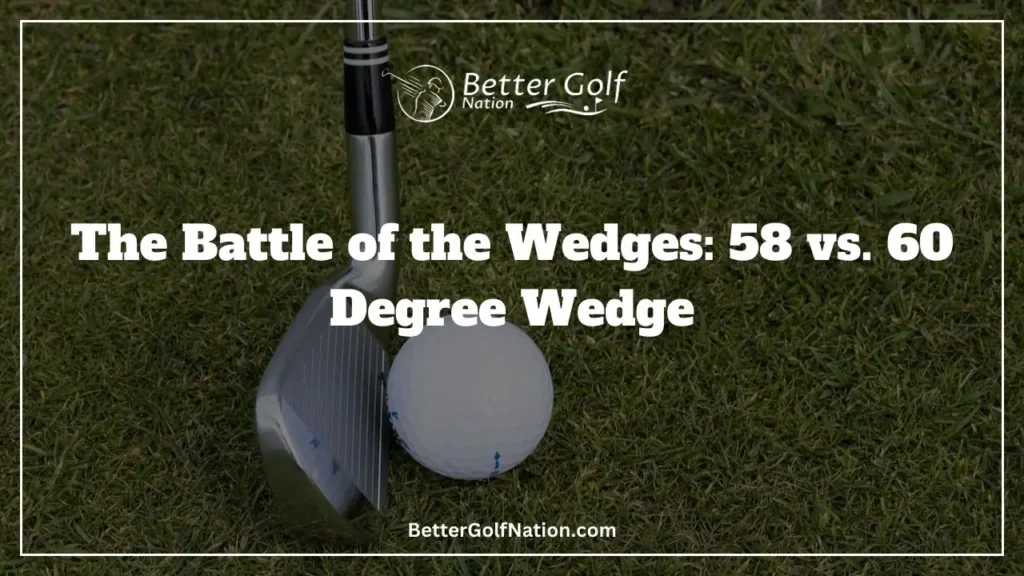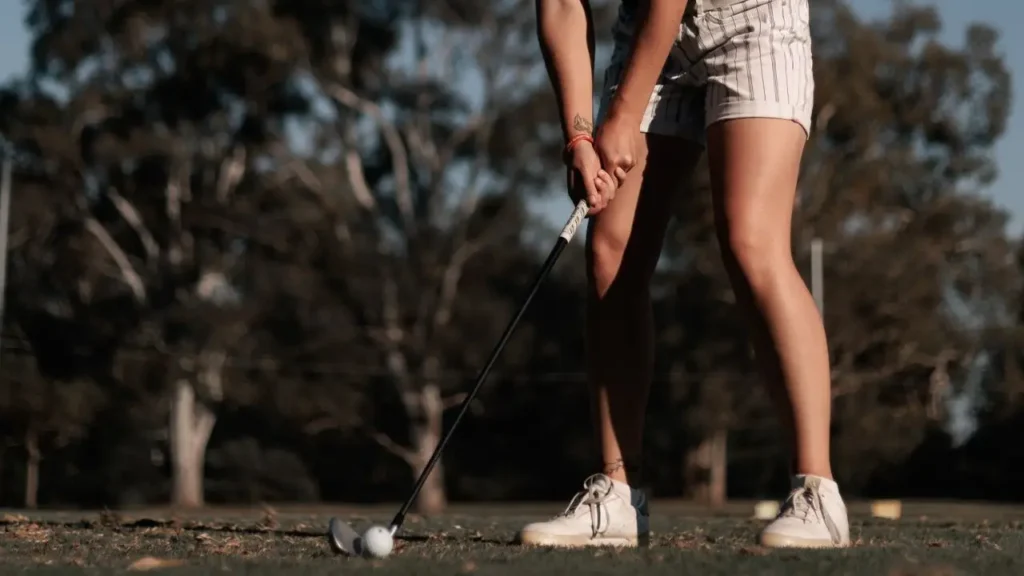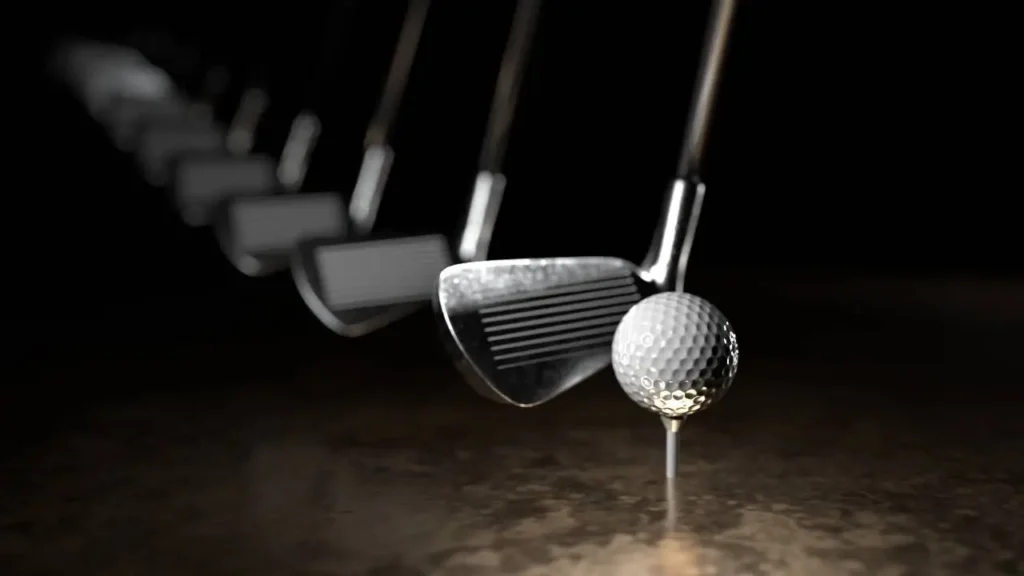The Battle of the Wedges: 58 vs. 60 Degree Wedge
- Last updated on February 14, 2024
- Toni Benedito
- Golf Equipment & Gear, Blog
While a 60-degree wedge provides high-trajectory shots with less roll, often preferred for extreme situations, a 58-degree wedge may offer you more versatility. Assessing these wedges’ benefits based on your individual needs and playing conditions can significantly enhance your short-game distance control and improve your decision-making on the golf course.

Key Takeaways
- Golf wedges are crucial for short-game control. Sand and lob wedges, commonly used for added control around greens, have loft angles like 54–56 degrees and 60–64 degrees, respectively.
- Consider your playing style and preferences when choosing between a 58-degree and a 60-degree wedge. The 60-degree offers higher trajectory shots, while the 58-degree provides versatility in controlling both distance and spin.
- Opt for a 58-degree wedge for shots requiring precision over power, like high shots that stop quickly on the green. It’s ideal for various situations, including bunker shots, flop shots, and scenarios with soft turf.
- The 60-degree wedge excels in getting the ball up quickly, making it suitable for clearing obstacles and achieving maximum backspin on firm greens. It’s valuable for short-range pitches from bunkers and tight lies.
- The choice between a 58-degree and a 60-degree wedge depends on personal preferences and playing style. Understanding the advantages and disadvantages of each loft angle helps golfers make informed decisions for their game.
Introduction
Golf equipment and gear have evolved significantly over the years, especially when it comes to golf wedges. Wedges are essential to any golfer’s game because they offer a high degree of control in the short game, which ultimately leads to better scores on the course.
There are several types available: pitching wedge, gap wedge, sand wedge, and lob wedge. Of these options, sand and lob wedges are most commonly used by golfers looking for extra control around the greens.
Sand wedges typically have 54 or 56 degrees of loft and are designed to help players escape from bunkers with ease. On the other hand, lob wedges usually range between 60 and 64 degrees of loft and provide maximum control over trajectory for short shots such as chips or pitches onto the green.
Enjoying this article? Read more:
Check out this video below from MrShortGame Golf‘s YouTube channel:
While both 58-degree and 60-degree wedges can come in handy in certain situations on the course, many golfers tend to overlook the importance of understanding their differences before making a purchase. When choosing between a 58-degree or a 60-degree wedge, keep in mind that each option has its benefits depending on your playing style and preferences.
The key is figuring out what type of shot you need to execute before selecting your club. In my experience, I have found that most players tend to lean towards using a 60-degree wedge for more extreme situations that require higher trajectory shots with less roll.
I believe that a well-lofted gap or sand wedge (such as a 54- or 56-degree option) can also get you out of sticky situations while offering greater overall versatility. Overall, whether you’re just starting with golf or you’re looking to upgrade your accessory collection with training aids like a new set of wedges, understanding how they work for your unique needs will help improve your game’s short-game distance control and ultimately help you make better decisions on the course.

Golf Equipment and Gear
When it comes to golf, having the right equipment and gear can make all the difference in your game.
And one of the most important pieces of equipment in your bag is, undoubtedly, your wedges. Wedges are designed to give you more control and precision when hitting short-range shots, such as those from within 100 yards of the green.
There are several different types of wedges available, but two that are commonly compared are the 58-degree wedge and the 60-degree wedge. But before we dive into comparing these two wedges, let’s first talk about why having a good set of wedges is so important.
The use of wedges can help you get out of tricky situations, such as bunkers or rough grass, with greater ease and accuracy. By using a wedge with more bounce, for example, you can prevent your club from digging too deep into the sand or grass and causing a mishit shot.
As any avid golfer knows, courses come in all shapes and sizes with varying obstacles that require different shot types. That’s why it’s important to have a full wedge set at your disposal, so you can select the right wedge for each specific shot on any given course.
"When it comes to golf, having the right equipment and gear can make all the difference in your game. Wedges are designed to give you more control and precision when hitting short-range shots. The choice between a 58-degree and a 60-degree wedge boils down to personal preference, with each offering distinct advantages for different situations."
But even within this set, it’s crucial to choose the right degree of loft for each type of shot. Now let’s specifically talk about comparing the 58-degree wedge to the 60-degree wedge.
The degree comparison may seem minor, but even just two degrees can make a significant difference in how you approach your golf wedge use on certain shots. While both clubs can be used for similar shots around the green, some key differences make each one better suited for certain situations.
In my opinion (and many others), choosing the right wedge is all about control—both over distance and spin. While some golfers may prefer a higher lofted club like a 60-degree wedge because they believe it gives them more spin and height on their shots, I find that the 58-degree wedge offers more versatility in terms of controlling both distance and spin.
Plus, with a slightly lower-degree loft, it can be easier to get out of tighter lies or hit low runners. Ultimately, the choice between these two wedges comes down to personal preference and what feels best for your golf wedge play.
Enjoying this article? Read more:

Understanding Golf Wedges
Golfers have a plethora of clubs to choose from when they are standing at the tee box, but it is the wedge selection that can make or break their game.
Golf wedge selection is an art form, and it all begins with understanding golf wedges. A traditional set of clubs includes 14 clubs, which range from a driver to a putter.
The clubs in between these two are called irons, and they come in sets of varying degrees of loft. However, it’s the wedges that play a critical role in every golfer’s game.
These clubs typically have higher lofts than irons and are designed to help golfers overcome obstacles like bunkers or rough terrain. When discussing golf wedges, most people think about sand wedges and lob wedges, which is not surprising since those two types are commonly used around greens.
But other types of golf wedges can be just as important for any golfer’s bag. Gap wedges (also known as approach or utility wedges) are becoming increasingly popular because they fill the space between your pitching wedge and your sand wedge, degree-wise.
"Understanding the role of wedges in overcoming obstacles is crucial. Gap wedges, often overlooked, bridge the gap between pitching and sand wedges. The degree of loft determines trajectory and distance control, influencing how the ball travels. Choosing wedges wisely, focusing on versatility and consistency, improves golf wedge play and contributes to better scores.
Dimples help break up this airflow and create turbulence that reduces drag while increasing lift forces. The depth of dimples also plays an important role in their impact on a golf ball’s aerodynamics.
Shallow or too-deep depressions can negatively impact lift and drag forces. Therefore, manufacturers carefully control their size and spacing to achieve optimal flight characteristics.
To give some examples of variations in the number of dimples, Titleist balls typically have around 392–396 dimples, while Bridgestone balls usually have around 330–350. Generally speaking, though, any number between 300 and 500 is considered standard for most modern-day golf balls.
Although there isn’t one specific answer for how many dimples are on a standard golf ball, it’s safe to say that most modern-day models will fall within the range of 300–500 dimples with varying depths based on manufacturer preference for aerodynamic impact. By choosing among different brands and models, we can find additional factors that are worth considering, including a ball’s compression, spin rates, and overall durability.

58 vs 60-Degree Wedge: The Basics
When it comes to discussing golf wedges, the 58-degree vs. 60-degree wedge debate has been ongoing for years. While both clubs have their uses on the green, it’s important to understand the differences between them to make an informed decision about which one to use in any given situation. First, let’s talk about these wedges and how they differ.
The loft angle of a golf club refers to the degree to which the clubface is angled upward from the ground. The higher the loft angle, the higher the trajectory a shot will have.
A 58-degree wedge has less loft than a 60-degree wedge, meaning that shots hit with it will go slightly farther but won’t be quite as high as those hit with a 60-degree wedge. So when would you want to use each of these wedges?
The answer largely depends on your game and the course you’re playing on. Generally speaking, most golfers will use a 58-degree wedge for shots that require more distance but still need some height to clear hazards or stop quickly on greens.
On the other hand, a 60-degree wedge is typically used for short shots around greens where maximum height and spin are necessary. Of course, many other factors come into play when comparing these two wedges.
For example, bounce plays a crucial role in how well each club performs in different situations. A higher-bounce wedge like a sand wedge degree might be better suited for courses with deep, rough, or soft bunkers, while a lower-bounce option like a gap wedge could work well on firm courses where control is more important than stopping power.
Ultimately, choosing between a 58-degree wedge and a 60-degree wedge comes down to personal preference and understanding your strengths and weaknesses as a golfer. Take some time to compare wedges and experiment with different options until you find what works best for you; after all, the right wedge set can make a huge difference in your golf wedge performance and overall enjoyment of the game.

Enjoying this article? Read more:
Check out this video below from We play golf‘s YouTube channel:
When to Use a 58-Degree Wedge
It’s no secret that the short game is where golfers make or break their scores. The right wedge can make all the difference between a birdie and a bogey.
That’s why sand wedge selection is so crucial in golf wedge play. One of the most versatile wedges in a golfer’s bag is the 58-degree wedge.
It can be used for many different shots around the green, from chipping to bunker shots to flop shots. But when should you select this club over your other options?
First off, let’s talk about distance control. The 58-degree wedge has a shorter shaft and a higher loft than most other clubs in your bag, which makes it perfect for those short-game shots that require more precision than power.
You’ll want to use this club when you need to hit a shot that travels high and stops quickly, like when there isn’t much green to work with. Another reason you might choose your 58-degree wedge is its ability to produce spin.
When you hit a shot with this club, it puts plenty of backspin on the ball, which gives you more control over its trajectory and direction. A third factor to consider when selecting your golf wedge choice is course conditions.
If you’re playing on a course with soft turf or fluffy sand in its bunkers, using your 58-degree wedge will help prevent those deep divots that can kill your momentum. Let’s talk about flop shots: those sky-high arcs that land softly on the green and stop dead in their tracks.
The 58-degree wedge is perfect for hitting these kinds of shots because its high loft allows you to get plenty of height on the ball without sacrificing accuracy or distance. Overall, if you’re looking for versatility and precision around the greens, then choosing the right wedge means considering all your golf wedge options, including a good 58-degree option.
Enjoying this article? Read more:

When to Use a 60-Degree Wedge
The 60-degree wedge is an incredible tool for golfers looking to improve their short-game performance. Its high loft allows for a soft landing on the green and precise control over the ball’s spin and trajectory. But when should you use a 60-degree wedge?
Let’s dive into that question. First and foremost, the 60-degree wedge is perfect for shots where you need to get the ball up in the air quickly.
Whether it’s to clear a bunker or an obstacle, this club will help you get the lift you need to get over anything in your way. Additionally, this club makes it easy to hit high, soft shots onto the green from tight lies around the putting surface.
Another time when I highly recommend using a 60-degree wedge is when you’re dealing with firm greens that require a lot of backspin to hold your shot near the target. With its high loft and sharp grooves, this club can generate plenty of spin on your ball that will make it stop quickly upon landing on even some of the hardest courses.
Let’s not forget about short-range pitches from around or off of greenside bunkers. The 60-degree wedge can help you finesse these kinds of shots like no other club can.
Its loft makes it simple to pop your ball out of those pesky divots or sand traps with ease. There are many excellent opportunities where using a 60-degree wedge can help elevate your game on any course.
While it might not be wise to always select this option over others like a sand wedge or pitching wedge since each iron has its own unique benefits, the choice should depend on what shot suits best for each scenario encountered on every hole played.
Enjoying this article? Read more:
Check out this video below from Golf Sidekick EXTRAS YouTube channel:
Comparing 58 vs 60 Degree Wedge
When it comes to wedge options, golfers have more choices than ever before.
Selecting the right wedge for your game can be a challenging task. Two of the most commonly used wedges are 58 and 60 degrees, which are both great for versatility in short-game shots.
The degree comparison between these two wedges may seem minor, but it can make a significant difference in your golf wedge play. The loft of a 58-degree wedge provides the perfect balance between distance and trajectory.
It is an excellent choice for golfers who struggle with consistency when using their sand wedge from bunkers or rough lies. The bounce is critical when using this club because too little or too much bounce can result in bad shots.
On the other hand, a 60-degree wedge has more loft than a standard sand wedge, making it the best wedge for delicate greenside shots and lobbing over hazards. It provides optimal control around the green and helps players hit high-trajectory shots with ease.
"Choosing between a 58 and 60-degree wedge? It's about balance vs. lift. The 58-degree offers consistency in various situations, while the 60-degree excels in delicate greenside shots. Your pick depends on style and game goals—precision or maximizing distance."
Golfers who prefer to use a higher-lofted sand or lob wedge will find that this club is essential to their arsenal. When comparing these two clubs side by side, each has its advantages and disadvantages, depending on your golf style and preferences.
For instance, if you want to maximize your distance while still maintaining loft, then choosing a 58-degree angle may be your best option. On the other hand, if you have difficulty controlling trajectory and need maximum lift for difficult greenside shots, then opting for a 60-degree would be ideal.
Choosing between these two clubs depends on what you’re looking to achieve in your golf game as well as your overall performance goals. Whether you’re deciding to invest in new accessories or training aids to improve your techniques or need help selecting the right club set that works best with your style of play, using either of these wedges will significantly enhance your short game.
Enjoying this article? Read more:

Choosing the Right Wedge for Your Game
When choosing the right wedge, don’t just rely on what your buddies are using or what you see the pros using. The key is to find a wedge that fits your game, swing, and shots on the course. So let’s dive into some tips for selecting the perfect wedge.
- First off, consider your skill level and typical shot patterns. If you’re a beginner or struggle with consistency, a higher-degree sand wedge, such as a 60-degree wedge, may not be ideal. It can be downright detrimental to your game if you’re not able to control trajectory and distance with such a high-lofted club. On the other hand, if you’re an advanced player who can generate spin and control with ease, a 60-degree wedge could be an asset in certain situations.
- Next up is bounce, an often overlooked factor in wedge selection. Bounce refers to the angle between the leading edge of the clubface and the sole of the clubhead. More bounce can help prevent digging in soft turf or sand, but it can also make it harder to make clean contact with the ball. Conversely, less bounce may lead to better turf interaction but can cause issues on bunkers or hard surfaces.
- Another key consideration is the gap in coverage among your clubs. A solid set should include wedges that have loft gaps of 4-6 degrees apart for optimal distance coverage. For example, having both a 54-degree and a 58-degree wedge would provide adequate separation without overlapping yardages. Don’t forget about the training aids or tools available to help you choose wedges that fit your game best.
Some golf shops offer services such as launch monitor testing or fitting sessions, where they analyze your swing data and recommend specific clubs tailored to your needs based on factors like swing speed and ball flight tendencies. Choosing the right golf wedges is all about finding what works for your game.
Consider factors like skill level, shot patterns, bounce, gap coverage, and tools available to help make the most informed decision. By selecting the proper wedges for your bag, you’ll be on the path to greater control and overall improvement in your short game.

Improving Your Game with the Right Wedge
Selecting the right wedge is crucial to your golf game. Having an arsenal of wedges in your bag, including a 54-degree wedge, can help you improve your game and lower your scores.
But knowing which wedge to use in each situation can be tough. That’s why it’s important to understand the differences between a 58- and a 60-degree wedge and how each one can impact your golf wedge performance.
One great way to improve your game with the right wedge is by using training aids, such as a wedge selector tool. This tool can help you determine which club to use in various situations based on factors like distance from the hole and type of lie.
This can take some of the guesswork out of choosing the right club and help you make better shots on the course. Another way to improve your game with the right wedge is by paying attention to your divots.
Divots provide valuable feedback about how you’re striking the ball with each club, including wedges. By analyzing your divots after each shot, you can make adjustments to technique or club selection as needed.
When it comes to sand shots, selecting the right sand wedge is key. The bounce of a sand wedge impacts how it interacts with the sand, making it easier or harder for golfers to get their ball out of bunkers or other hazards.
By understanding bounce and selecting a sand wedge with an appropriate bounce for each shot, golfers can significantly improve their performance around greens. Improving your game with the right wedges takes knowledge and practice.
Understanding differences between clubs like a 58-degree vs. 60-degree wedge and taking advantage of training aids like a selector tool are just two ways golfers can up their game when it comes to selecting equipment on the course. Paying attention to divots and using appropriate clubs for sand shots are also critical components of success for those looking to lower their scores and elevate their performance.
Enjoying this article? Read more:
Check out this video below from Golf Sidekick EXTRAS YouTube channel:
Conclusion
As we reach the end of this article comparing 58- and 60-degree wedges, it is important to note that selecting the right wedge for your game can make all the difference. The golf wedge selection process can be overwhelming, but hopefully, this article has shed some light on these two loft options and their uses.
When it comes down to it, golfers need to decide which wedge will give them the most confidence on the course. While many may argue that the 60-degree wedge is necessary for all short-game situations, I stand firm in my belief that the 58-degree wedge is a better option for most average golfers.
The 58-degree wedge offers versatility and consistency that are unmatched by its high-lofted counterpart. With its lower loft, golfers have more control over their shots and can better predict how far their ball will travel.
This makes it easier to hit crisp chip shots and pitch shots with greater accuracy. Of course, there are situations where a higher-lofted club like a 60-degree wedge may be necessary; however, I would argue that these situations are few and far between.
For most courses and most golfers, a well-rounded set of wedges, including a gap wedge or sand wedge paired with a trusty 58-degree option, will suffice. When comparing 58- and 60-degree wedges, I firmly believe that the right choice comes down to personal preference and playing style.
While both clubs have their advantages and disadvantages depending on how they are used out on courses, ultimately choosing one club over another should come down to what feels best in your hands during play. Experimenting with different wedges or using a golf wedge selector tool can help you find the right fit for your game, so you can improve your short-game scores and enjoy playing even more!
Share this Post
Toni Benedito
Keep Reading
Follow Us
Recent Posts

How Do Pro Golfers Get Paid? The Business of Golf
Professional golfers get paid both before and after tournaments. Before a tournament, they receive appearance fees, sometimes exceeding $1 million, to attract top players. After the tournament, earnings depend on their placement, with the PGA

How Much Do Golf Players And Pros Make? You Won’t Believe It!
Professional golfers earn substantial incomes through tournament winnings, sponsorship deals, and endorsements. Top players on the PGA Tour can make millions annually, with significant earnings from prize money and lucrative brand partnerships. For example, Rory

The Shocking Cost: How Much Does It Cost to Fly with Golf Clubs?
Flying with golf clubs can be a hassle, but it’s worth it for avid golfers. Costs vary by airline, ranging from $30 to $150 per way. Southwest Airlines offers a generous policy, allowing one set

Why Do Golfers Tape Their Fingers Before Hitting the Course?
Golfers tape their fingers to prevent injuries from repetitive motions, provide support for existing injuries, and improve grip comfort. It’s a popular technique among amateurs and pros alike, offering a lightweight and effective solution compared

How Much Does a Round of Golf Cost? Are You on Par?
The cost of a round of golf varies widely based on factors like course type, location, and time of play. Public courses typically range from $30-$100 per round, while exclusive ones like Augusta National or

Hidden Fees: How Much Does It Cost To Rent a Golf Cart
Wondering how much it costs to rent a golf cart? Explore factors like location, rental duration, and cart type impacting prices. Daily rates range from $50 to $80, while weekly rentals can vary from $200
Table of Contents







